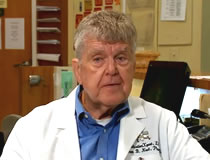August 20th, 2012
Bone Drug ONJ Triggered by Dental Work
Reviewed by Robert Jasmer, MD; Associate Clinical Professor of Medicine, University of California, San Francisco
Take PosttestAction Points
-- Dental extraction emerged as the dominant etiologic culprit in bisphosphonate
associated osteonecrosis of the jaw (ONJ) among patients with multiple myeloma
or Waldenstrom's macroglobulinemia.
-- Note that the cumulative bisphosphonate dose also played a role in a patient's
predisposition to ONJ.
Dental extraction emerged as the dominant etiologic culprit in bisphosphonate-associated osteonecrosis of the jaw (ONJ) among patients with multiple myeloma or Waldenstrom's macroglobulinemia, an Italian study showed.
In almost 80% of cases, patients reported recent dental alveolar surgery, including tooth extraction. In fact, all but one of 55 cases of ONJ occurred in association with some type of dental procedure. reported Alessandro Andriani, MD, of Ospedale Nuovo Regina Margherita in Rome, and colleagues online in Blood Cancer Journal.
The cumulative bisphosphonate dose also played a role in a patient's predisposition to ONJ, they said.
"A dental examination with preventive dentistry must be performed before starting [bisphosphonate] therapy, and some cautions must be used if dental problems appear during therapy," the authors advised. "The use of antibiotics for germ eradication, the indication to avoid tooth removal and dental implants, and the implementation of nonsurgical control of periodontal disease are universally recognized.
Bisphosphonate therapy should be individualized by patient, they added, and patients should not receive continuous therapy for more than 1 to 2 years.
ONJ has been reported as a complication of bisphosphonate therapy in 4% to 15% of cancer patients, including neoplastic and non-neoplastic conditions, the authors noted.
Several previous studies have reported an association between ONJ and dental or oral-cavity surgery among bisphosphonate users. Andriani and colleagues sought to describe in more detail the clinical characteristics and evolution of ONJ in patients with myeloma and Waldenstrom's macroglobulinemia.
The group explained that because of their clinical characteristics, these patients are the best candidates to be treated with bisphosphonates.
Investigators at 10 centers retrospectively examined records of patients with either of the hematologic malignancies and identified all who developed ONJ in association with bisphosphonate therapy. The search produced a total of 55 patients to include in the study.
Diagnostic criteria for ONJ consisted of presence of exposed or necrotic bone of the maxilla or mandible with or without pain; evidence of regional soft-tissue inflammatory swelling or infection; exposed bone with pathologic fracture with pain, swelling, or cutaneous fistula.
The involved site was the mandible in 29 patients, the maxilla in 22, and both in the remaining four. The trigger for ONJ was dental alveolar surgery in 43 patients, dental implant procedures in three, periodontal disease in five, dental prosthesis in three, and one case with no readily identifiable cause.
The authors determined that 12 of the 55 patients were in remission of their hematologic malignancy at the time of ONJ diagnosis.
By Ruggiero criteria, 46 of 55 (83.8%) patients had stage II ONJ.
Examination of patient treatment history showed that 10 (18%) patients developed ONJ within 12 months of starting bisphosphonate therapy, 16 (29%) between 12 and 24 months, 10 (18%) between 24 and 36 months, four (7%) after 36 to 48 months, and 15 patients (27%) after 48 months.
The treatment approach varied across the patient population:
51 received antibiotics
Six had surgical debridement in addition to antibiotics
16 had hyperbaric oxygen or ozonotherapy
12 had sequestrectomy plus hyperbaric oxygen
Treatment led to complete response in 20 patients and improvement in 21. However, the condition did not change in nine patients, and three had worsening of ONJ despite treatment. The authors found that surgery plus antibiotics and hyperbaric oxygen/ozonotherapy produced the best outcomes.
Univariate analysis of factors associated with response to therapy identified receipt of hyperbaric oxygen as the only significant predictor of response (P=0.007).
All of the patients received either zoledronic acid (Zometa) or pamidronate (Aredia), and the type of bisphosphonate did not influence outcome. However, total bisphosphonate dose did.
Using zoledronic acid as the reference, the authors found that a lower cumulative dose was associated with an increased likelihood of response. The association strengthened across the range of cutoff points from less than 80 mg to more than 130 mg.
The authors had no disclosures.
Primary source: Blood Cancer Journal
Source reference:
Andriani A et al. "Evolution of bisphosphonate-related osteonecrosis of the jaw in patients with multiple myeloma and Waldenstrom's macroglobulinemia: A retrospective, multicentric study" Blood Cancer J 2012; DOI: 10.1038/bcj.2012.9.
- August 30th, 2012
I Was Always Taught You Control The Pain, Not The DrugRead - December 4th, 2014
Sulfonylureas Tied to Higher Mortality in DiabeticsRead - October 3rd, 2014
Statin use may be linked to less physical activity in elderly menRead - September 6th, 2014
The Trouble with Serum Testosterone Testing (Important addition to Feb 2014 "I Told You So"Read - November 26th, 2013
FDA lifts some safety restrictions on GlaxoSmithKline's AvandiaRead
Geriatric Nutrition
Without good nutrition, positive drug therapy outcomes are very difficult to obtain, For the best in Geriatric Nutritional Information
Find out more Optima SolutionsContinuing Education
Each month we will post an analysis of specific aspects of government long-term healthcare regulations.
Find out more


